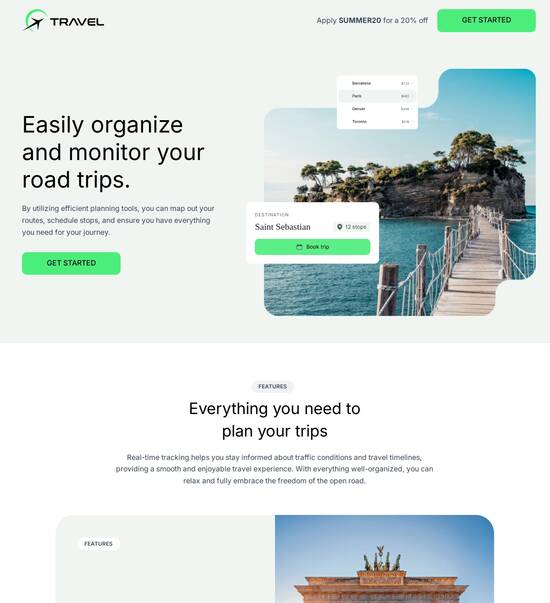
Data-driven wiki page template
Explore Similar TemplatesAbout template
Unleash your creativity with the data-driven wiki page template. Try Instapage today.
Recommended templates

Easy to build without coding
With the intuitive drag-and-drop builder, anyone on your team can create high-converting pages without any knowledge of code or design. Make enhancements to your landing page with custom widgets using Javascript, HTML/CSS, or third-party scripts.

Multiple layouts for any industry and goal
Select from 500+ landing page layouts built to boost conversions across industry-specific scenarios. Customize them by adjusting fonts, adding images, and generating on-brand content with the AI assistant. Quickly scale with Instablocks® and Global Blocks that you can save, reuse, and update globally.

Loads fast and looks polished on any device
Every template is responsive, which means they present professionally on any device and load blazingly fast with our Thor Render Engine. You can also power them up with Google AMP technology to deliver an unparalleled mobile experience and drive higher conversions.

Robust analytics & experimentation
Get real-time updates and reporting across all your devices, showing the number of visitors, conversions, cost-per-visitor, and cost-per-lead. Launch AI-powered experiments, run A/B tests, and use heatmaps to analyze user behavior, then optimize your landing page to maximize conversions.







Easy to build without coding
With the intuitive drag-and-drop builder, anyone on your team can create high-converting pages without any knowledge of code or design. Make enhancements to your landing page with custom widgets using Javascript, HTML/CSS, or third-party scripts.
Multiple layouts for any industry and goal
Select from 500+ landing page layouts built to boost conversions across industry-specific scenarios. Customize them by adjusting fonts, adding images, and generating on-brand content with the AI assistant. Quickly scale with Instablocks® and Global Blocks that you can save, reuse, and update globally.
Loads fast and looks polished on any device
Every template is responsive, which means they present professionally on any device and load blazingly fast with our Thor Render Engine.
Robust analytics & experimentation
Get real-time updates and reporting across all your devices, showing the number of visitors, conversions, cost-per-visitor, and cost-per-lead. Launch AI-powered experiments, run A/B tests, and use heatmaps to analyze user behavior, then optimize your landing page to maximize conversions.
All the features you need to build lead-generating landing pages
Explore more featuresLearn how to build top-performing landing pages for any goal
FAQs
Leading the way in building high-performing landing pages





A guide to using Instapage for optimizing landing page conversion rates
Effective landing page optimization is critical for maximizing the return on investment of your digital marketing campaigns. Instapage is a powerful tool that helps marketers enhance their landing page performance through optimized design and efficient conversion rate optimization (CRO) strategies.
Understanding landing pages and their importance
Landing pages are standalone web pages designed to capture leads and drive conversions. They offer a focused message directed at a specific audience, improving user engagement and guide potential customers toward taking action. In a competitive landscape, leveraging Instapage's built-in tools can greatly enhance your landing page effectiveness.
- Tailored messaging: Customize your content to resonate with specific audience segments.
- A/B testing: Experiment with different designs and layouts to identify the highest performing versions of your landing pages.
- Analytics tracking: Monitor user interactions to refine strategies and boost performance.
Steps to create optimized landing pages using Instapage
To create landing pages that convert, start by selecting a high-converting template. Instapage offers more than 100 pre-designed templates that can be easily customized to align with your branding.
Advanced optimization techniques
Optimization does not stop with design. It's essential to analyze user behavior actively. Take advantage of Instapage's heatmaps and A/B testing features to refine your approach.
- Heatmaps: Visualize where users click on your page to improve layout.
- A/B Testing: Test variations of headlines or calls to action to find the most effective option.
- Dynamic text replacement: Use personalized content to improve engagement and relevance.
Collaboration and feedback mechanisms
Collaborating with your marketing team is simplified with Instapage's feedback features. The platform allows real-time edits and discussions, ensuring a smooth workflow from concept to launch.
- Instant feedback: Comment on specific elements directly within the page editor.
- Real-time edits: Update content as needed with team members on the project.
- Stakeholder sharing: Easily share landing pages with stakeholders for prompt approvals.
Incorporating these strategies will dramatically enhance your landing page's conversion power.
Get started with Instapage today and transform your landing pages into a dynamic marketing tool that drives real results.
People also ask about Data-driven wiki page template
Understanding the data-driven wiki page template: A comprehensive breakdown
The concept of data-driven wiki pages
Data-driven wiki pages represent a significant advancement in how information is organized and accessed. At its core, a data-driven wiki integrates live data sources within its structure. This evolution improves the user experience by targeting information directly relevant to users' queries and interests. By providing real-time data updates, these pages ultimately enhance user engagement and efficiency, fostering a more interactive environment for knowledge sharing.
The significance of data-driven wiki pages cannot be overstated. Unlike traditional wikis, which rely on static content, data-driven wikis leverage various data input methods, allowing for integrated information that updates without manual intervention. This automation not only saves time but also ensures that users access the most current information, supporting informed decision-making.
Real-time updates: Content reflects live data, enhancing relevance.
Collaborative editing: Multiple users can work simultaneously, streamlining contributions.
Data visualization: Innovative methods to present data clearly and engagingly.
These features make data-driven wikis distinct from their traditional counterparts, turning them into powerful tools for businesses, educational institutions, and research organizations.
Architectural framework of data-driven wiki pages
Understanding the structural components of a data-driven wiki page is essential for effective utilization. A well-designed template typically comprises essential elements such as headers, footers, and navigation menus. These components serve as frameworks for content organization, ensuring users can navigate easily and find the information they need without confusion.
Customizable elements allow users to adjust their templates according to personal preferences. Adjustments might include selecting color schemes, rearranging content blocks, or modifying fonts. This flexibility is crucial, as it enables users to create spaces that align with their branding or individual project goals, ultimately leading to enhanced user experience.
In terms of module integration, it’s beneficial to incorporate various modules into wiki pages. Modules might include content blocks for text or video, charts for data representation, and embedded data sources for real-time information. Utilizing multiple modules effectively can create a robust and informative page that meets diverse user needs.
Categories and organization of content
Establishing categories is vital for enhancing content discoverability within a data-driven wiki. Well-structured categories allow users to navigate the information intuitively. For organizations with expansive datasets, categorization becomes even more critical as it helps streamline content searching and retrieval.
Creating and maintaining categories involves understanding user needs and ensuring they align with the content organization's objectives. Regular updates and refinements to categories ensure that they remain relevant and useful over time. Techniques for refining categorization can include gathering user feedback and monitoring search queries.
Manual creation: Set categories that reflect primary topics.
Dynamic generation: Use algorithms to create categories based on content tags.
Dynamic listings of items also enhance the user experience in data-driven wikis. These lists can automate the showcasing of relevant content based on user queries or data attributes, ensuring that users quickly find what they’re looking for without excessive searching.
Design elements that enhance data-driven pages
Aesthetics play a significant role in creating engaging data-driven wiki pages. Color schemes, typography, and imagery should complement data visuals without overpowering them. Attention to these design elements can significantly affect how users perceive and interact with content.
Furthermore, ensuring that the design is responsive is crucial. As more users access content from mobile devices, responsive designs can adapt seamlessly, providing optimal viewing experiences irrespective of device type.
Best practices for data visualization within wiki templates include principles of clarity, simplicity, and accuracy. Effective visuals should communicate data insights at a glance. Tools such as Infogram, Google Charts, and Tableau allow users to create impactful charts and graphs, helping to translate complex data into digestible formats.
Wiki automation: Streamlining content management
Wiki automation is essential in managing large datasets effectively. By automating repetitive tasks such as content updates, user permissions, and data integrations, organizations can improve efficiency and reduce the chances of human error. Automated systems can provide real-time updates, ensuring that all information stored in the wiki is current.
Identifying software tools that enhance automation can significantly simplify the management of data-driven wiki pages. For instance, integration with project management applications or data collection platforms allows seamless data flow into the wiki, ensuring that users interact with the latest information without manual data entry.
Automated content updates: Use scripts or integration tools to refresh information.
User permission management: Automate user role assignments based on predefined rules.
These synergistic benefits create a smooth and efficient workflow, leading to enhanced productivity and collaboration across teams.
Practical applications of data-driven wiki templates
Data-driven wiki templates have varied applications across multiple industries. In education, they can provide students with up-to-date resources and collaborative learning experiences. For corporations, they can create central repositories for knowledge management that facilitate onboarding and continuous training.
Real-world case studies illustrate the effectiveness of employing templates tailored to specific use cases. For instance, healthcare organizations can utilize data-driven wikis to track patient data and outcomes, streamlining information for healthcare professionals. Similarly, technology firms may adopt data-driven wikis to support product development and enhance team collaboration.
Education: Centralized resources and collaborative learning tools.
Corporate: Knowledge management systems for onboarding and training.
Healthcare: Efficient tracking of patient data and treatment plans.
These applications highlight the immense potential data-driven wikis have to enhance collaboration and knowledge sharing within organizations.
Challenges and considerations in implementing data-driven wiki pages
Despite the numerous advantages of data-driven wiki pages, implementing them can present various challenges. Common roadblocks include data overload, which can overwhelm users if there is too much information; user resistance due to fear of change; and technical difficulties related to integration and data management.
To mitigate these challenges, organizations should invest in training for users, create clear guidelines for content management, and gradually introduce automation instead of an abrupt overhaul. Gathering user feedback throughout the implementation process can also uncover areas requiring attention, leading to a smoother transition.
Looking ahead, future trends in wiki development are likely to incorporate emerging technologies such as AI and machine learning. These advancements will enhance personalization and make content discovery more intuitive, ultimately improving user experiences within data-driven wiki environments.
Crafting an effective data-driven wiki page
Creating a data-driven wiki page template requires a systematic approach. Begin by defining the purpose of the page, determining which data points are most relevant to your audience. Next, sketch an outline of your layout, identifying where various content types, modules, and visual elements will reside. This foundational work paves the way for a well-structured template that meets user needs.
After its launch, maintaining and updating your wiki pages will be vital to ensure continued relevance and accuracy. Develop a schedule for periodic reviews and content updates, drawing upon analytics to determine which sections require attention. Also, establish a feedback loop, encouraging users to share insights on what works and what doesn’t. This iterative approach will guide ongoing improvements.
Define the purpose and relevant data points before layout design.
Regularly review and update content based on user interaction.
Encourage user feedback to foster continual improvements.
Conclusion: Transforming wiki pages through data integration
In summary, data-driven wiki templates offer significant benefits, ranging from enhanced user engagement to more efficient data management. By integrating real-time data, optimizing user experiences, and fostering collaboration, these templates can revolutionize how organizations share knowledge and manage content.
As businesses and educational institutions increasingly adopt this approach, embracing the potential of data-driven wiki page templates can lead to better knowledge management, elevated collaboration, and ultimately improved outcomes.
Ready to skyrocket conversions?
Supercharge your ad campaigns with high-performing landing pages
Get started














